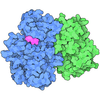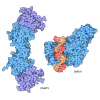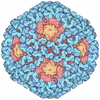+ Open data
Open data
- Basic information
Basic information
| Entry | Database: PDB / ID: 8dji | ||||||
|---|---|---|---|---|---|---|---|
| Title | Ternary complex of SUMO1 with the SIM of PML and zinc | ||||||
 Components Components |
| ||||||
 Keywords Keywords | NUCLEAR PROTEIN / SUMO1 / PML Nuclear Bodies / Zinc / auto-inhibition / Daxx | ||||||
| Function / homology |  Function and homology information Function and homology informationregulation of calcium ion transport into cytosol / ubiquitin-like protein ligase activity / negative regulation of translation in response to oxidative stress / positive regulation of protein localization to chromosome, telomeric region / negative regulation of potassium ion transmembrane transporter activity / protein localization to nuclear pore / suppression of viral release by host / : / SUMOylation of nuclear envelope proteins / SUMO is proteolytically processed ...regulation of calcium ion transport into cytosol / ubiquitin-like protein ligase activity / negative regulation of translation in response to oxidative stress / positive regulation of protein localization to chromosome, telomeric region / negative regulation of potassium ion transmembrane transporter activity / protein localization to nuclear pore / suppression of viral release by host / : / SUMOylation of nuclear envelope proteins / SUMO is proteolytically processed / Negative regulation of activity of TFAP2 (AP-2) family transcription factors / SUMO is conjugated to E1 (UBA2:SAE1) / negative regulation of delayed rectifier potassium channel activity / PML body organization / negative regulation of DNA binding / SUMO is transferred from E1 to E2 (UBE2I, UBC9) / negative regulation of action potential / nuclear stress granule / SUMO binding / small protein activating enzyme binding / positive regulation of apoptotic process involved in mammary gland involution / fibroblast migration / SMAD protein signal transduction / myeloid cell differentiation / SUMOylation of DNA methylation proteins / SUMOylation of immune response proteins / SUMOylation of SUMOylation proteins / protein-containing complex localization / maintenance of protein location in nucleus / XY body / regulation of calcium ion transmembrane transport / endoplasmic reticulum calcium ion homeostasis / Maturation of nucleoprotein / regulation of double-strand break repair / branching involved in mammary gland duct morphogenesis / SUMOylation of RNA binding proteins / oncogene-induced cell senescence / Regulation of RUNX1 Expression and Activity / negative regulation of mitotic cell cycle / Transferases; Acyltransferases; Aminoacyltransferases / regulation of cardiac muscle cell contraction / SUMO transferase activity / Postmitotic nuclear pore complex (NPC) reformation / positive regulation of extrinsic apoptotic signaling pathway / cobalt ion binding / Maturation of nucleoprotein / intrinsic apoptotic signaling pathway in response to oxidative stress / negative regulation of interleukin-1 beta production / negative regulation of protein import into nucleus / SUMOylation of ubiquitinylation proteins / entrainment of circadian clock by photoperiod / transcription factor binding / SMAD binding / ubiquitin-specific protease binding / negative regulation of telomere maintenance via telomerase / positive regulation of telomere maintenance / cellular response to cadmium ion / roof of mouth development / SUMOylation of transcription factors / ubiquitin-like protein ligase binding / SUMOylation of DNA replication proteins / protein sumoylation / negative regulation of ubiquitin-dependent protein catabolic process / positive regulation of signal transduction by p53 class mediator / intrinsic apoptotic signaling pathway in response to endoplasmic reticulum stress / intrinsic apoptotic signaling pathway in response to DNA damage by p53 class mediator / cell fate commitment / potassium channel regulator activity / Regulation of IFNG signaling / postsynaptic cytosol / nuclear pore / transporter activator activity / protein targeting / negative regulation of DNA-binding transcription factor activity / regulation of cell adhesion / SUMOylation of DNA damage response and repair proteins / response to UV / retinoic acid receptor signaling pathway / presynaptic cytosol / Regulation of TP53 Activity through Acetylation / extrinsic apoptotic signaling pathway / positive regulation of defense response to virus by host / response to cytokine / Transcriptional and post-translational regulation of MITF-M expression and activity / cellular response to interleukin-4 / transforming growth factor beta receptor signaling pathway / SUMOylation of transcription cofactors / Regulation of PTEN localization / SUMOylation of chromatin organization proteins / negative regulation of angiogenesis / cellular response to leukemia inhibitory factor / response to gamma radiation / DNA damage response, signal transduction by p53 class mediator / positive regulation of protein-containing complex assembly / SUMOylation of intracellular receptors / circadian regulation of gene expression / negative regulation of cell growth / regulation of circadian rhythm / PML body / PKR-mediated signaling Similarity search - Function | ||||||
| Biological species |  Homo sapiens (human) Homo sapiens (human) | ||||||
| Method |  X-RAY DIFFRACTION / X-RAY DIFFRACTION /  SYNCHROTRON / SYNCHROTRON /  MOLECULAR REPLACEMENT / Resolution: 1.97 Å MOLECULAR REPLACEMENT / Resolution: 1.97 Å | ||||||
 Authors Authors | Lussier-Price, M. / Wahba, H.M. / Mascle, X.H. / Cappadocia, L. / Bourdeau, V. / Gagnon, C. / Igelmann, S. / Sakaguchi, K. / Ferbeyre, G. / Omichinski, J.G. | ||||||
| Funding support |  Canada, 1items Canada, 1items
| ||||||
 Citation Citation |  Journal: Nucleic Acids Res. / Year: 2022 Journal: Nucleic Acids Res. / Year: 2022Title: Zinc controls PML nuclear body formation through regulation of a paralog specific auto-inhibition in SUMO1. Authors: Lussier-Price, M. / Wahba, H.M. / Mascle, X.H. / Cappadocia, L. / Bourdeau, V. / Gagnon, C. / Igelmann, S. / Sakaguchi, K. / Ferbeyre, G. / Omichinski, J.G. | ||||||
| History |
|
- Structure visualization
Structure visualization
| Structure viewer | Molecule:  Molmil Molmil Jmol/JSmol Jmol/JSmol |
|---|
- Downloads & links
Downloads & links
- Download
Download
| PDBx/mmCIF format |  8dji.cif.gz 8dji.cif.gz | 69.6 KB | Display |  PDBx/mmCIF format PDBx/mmCIF format |
|---|---|---|---|---|
| PDB format |  pdb8dji.ent.gz pdb8dji.ent.gz | 50.2 KB | Display |  PDB format PDB format |
| PDBx/mmJSON format |  8dji.json.gz 8dji.json.gz | Tree view |  PDBx/mmJSON format PDBx/mmJSON format | |
| Others |  Other downloads Other downloads |
-Validation report
| Summary document |  8dji_validation.pdf.gz 8dji_validation.pdf.gz | 1.6 MB | Display |  wwPDB validaton report wwPDB validaton report |
|---|---|---|---|---|
| Full document |  8dji_full_validation.pdf.gz 8dji_full_validation.pdf.gz | 1.6 MB | Display | |
| Data in XML |  8dji_validation.xml.gz 8dji_validation.xml.gz | 6.5 KB | Display | |
| Data in CIF |  8dji_validation.cif.gz 8dji_validation.cif.gz | 8.1 KB | Display | |
| Arichive directory |  https://data.pdbj.org/pub/pdb/validation_reports/dj/8dji https://data.pdbj.org/pub/pdb/validation_reports/dj/8dji ftp://data.pdbj.org/pub/pdb/validation_reports/dj/8dji ftp://data.pdbj.org/pub/pdb/validation_reports/dj/8dji | HTTPS FTP |
-Related structure data
| Related structure data |  8djhC  6v7pS S: Starting model for refinement C: citing same article ( |
|---|---|
| Similar structure data | Similarity search - Function & homology  F&H Search F&H Search |
- Links
Links
- Assembly
Assembly
| Deposited unit | 
| ||||||||
|---|---|---|---|---|---|---|---|---|---|
| 1 |
| ||||||||
| Unit cell |
|
- Components
Components
| #1: Protein | Mass: 11043.335 Da / Num. of mol.: 1 Source method: isolated from a genetically manipulated source Source: (gene. exp.)  Homo sapiens (human) / Gene: SUMO1, SMT3C, SMT3H3, UBL1, OK/SW-cl.43 / Production host: Homo sapiens (human) / Gene: SUMO1, SMT3C, SMT3H3, UBL1, OK/SW-cl.43 / Production host:  | ||||
|---|---|---|---|---|---|
| #2: Protein/peptide | Mass: 2976.985 Da / Num. of mol.: 1 / Fragment: SIM Source method: isolated from a genetically manipulated source Source: (gene. exp.)  Homo sapiens (human) / Gene: PML, MYL, PP8675, RNF71, TRIM19 / Production host: Homo sapiens (human) / Gene: PML, MYL, PP8675, RNF71, TRIM19 / Production host:  References: UniProt: P29590, Transferases; Acyltransferases; Aminoacyltransferases | ||||
| #3: Chemical | | #4: Water | ChemComp-HOH / | Has ligand of interest | Y | |
-Experimental details
-Experiment
| Experiment | Method:  X-RAY DIFFRACTION / Number of used crystals: 1 X-RAY DIFFRACTION / Number of used crystals: 1 |
|---|
- Sample preparation
Sample preparation
| Crystal | Density Matthews: 1.98 Å3/Da / Density % sol: 38 % |
|---|---|
| Crystal grow | Temperature: 291 K / Method: vapor diffusion, hanging drop Details: 100 mM HEPES pH 7.0, 19 to 31 % (w/v) PEG 3350, and 1-5 mM zinc chloride |
-Data collection
| Diffraction | Mean temperature: 298 K / Serial crystal experiment: N |
|---|---|
| Diffraction source | Source:  SYNCHROTRON / Site: SYNCHROTRON / Site:  CHESS CHESS  / Beamline: F1 / Wavelength: 0.977 Å / Beamline: F1 / Wavelength: 0.977 Å |
| Detector | Type: DECTRIS PILATUS3 6M / Detector: PIXEL / Date: Mar 20, 2019 |
| Radiation | Protocol: SINGLE WAVELENGTH / Monochromatic (M) / Laue (L): M / Scattering type: x-ray |
| Radiation wavelength | Wavelength: 0.977 Å / Relative weight: 1 |
| Reflection | Resolution: 1.97→32 Å / Num. obs: 14192 / % possible obs: 96.58 % / Redundancy: 5.5 % / CC1/2: 0.982 / Net I/σ(I): 5.34 |
| Reflection shell | Resolution: 1.97→2.044 Å / Num. unique obs: 637 / CC1/2: 0.263 |
- Processing
Processing
| Software |
| |||||||||||||||||||||||||||||||||||||||||||||||||||||||||||||||||||||||||||||
|---|---|---|---|---|---|---|---|---|---|---|---|---|---|---|---|---|---|---|---|---|---|---|---|---|---|---|---|---|---|---|---|---|---|---|---|---|---|---|---|---|---|---|---|---|---|---|---|---|---|---|---|---|---|---|---|---|---|---|---|---|---|---|---|---|---|---|---|---|---|---|---|---|---|---|---|---|---|---|
| Refinement | Method to determine structure:  MOLECULAR REPLACEMENT MOLECULAR REPLACEMENTStarting model: 6V7P Resolution: 1.97→32 Å / SU ML: 0.32 / Cross valid method: THROUGHOUT / σ(F): 1.34 / Phase error: 30 / Stereochemistry target values: ML
| |||||||||||||||||||||||||||||||||||||||||||||||||||||||||||||||||||||||||||||
| Solvent computation | Shrinkage radii: 0.9 Å / VDW probe radii: 1.11 Å / Solvent model: FLAT BULK SOLVENT MODEL | |||||||||||||||||||||||||||||||||||||||||||||||||||||||||||||||||||||||||||||
| Displacement parameters | Biso max: 70.06 Å2 / Biso mean: 34.7233 Å2 / Biso min: 16.14 Å2 | |||||||||||||||||||||||||||||||||||||||||||||||||||||||||||||||||||||||||||||
| Refinement step | Cycle: final / Resolution: 1.97→32 Å
| |||||||||||||||||||||||||||||||||||||||||||||||||||||||||||||||||||||||||||||
| LS refinement shell | Refine-ID: X-RAY DIFFRACTION / Rfactor Rfree error: 0 / Total num. of bins used: 10
| |||||||||||||||||||||||||||||||||||||||||||||||||||||||||||||||||||||||||||||
| Refinement TLS params. | Method: refined / Refine-ID: X-RAY DIFFRACTION
| |||||||||||||||||||||||||||||||||||||||||||||||||||||||||||||||||||||||||||||
| Refinement TLS group |
|
 Movie
Movie Controller
Controller



 PDBj
PDBj
























